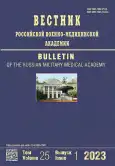Methods to increase the effectiveness of cytoreductive surgical interventions in patients with complicated disseminated tumors of the abdominal cavity and pelvis
- Authors: Nguyen V.1, Prosvetov V.A.1, Bromberg B.B.1, Dymnikov D.A.1, Loginov V.A.1, Demko A.E.1,2, Solovеv I.A.1,3, Surov D.A.1,2
-
Affiliations:
- Kirov Military Medical Academy
- Saint Petersburg Scientific Research Institute of Ambulance named after I.I. Janelidze
- Mariinskaya Hospital
- Issue: Vol 25, No 1 (2023)
- Pages: 23-32
- Section: Original Study Article
- URL: https://journals.rcsi.science/1682-7392/article/view/134083
- DOI: https://doi.org/10.17816/brmma120006
- ID: 134083
Cite item
Abstract
The expediency of performing two-stage cytoreductive interventions in patients with complicated disseminated tumors of the abdominal cavity and pelvis is presented. Ninety-two patients with complicated disseminated tumors of the abdominal cavity and pelvis were examined into two groups. The main group consisted of 33 patients who received surgical treatment by two-stage cytoreductive surgery. The control group included 59 patients who underwent single-stage cytoreductive operations. In both groups, life-threatening complications were dominated by primary tumor necrosis (main group, n = 15; control group, n = 31) and impaired intestinal patency (main group, n = 12; control group, n = 16, respectively). The average Charlson comorbidity index was 7.85 ± 1.37 and 7.53 ± 1.5 points, respectively. Anesthetic risk of grades III–IV according to the classification of the American Society of Anesthesiologists was detected in 23 (69.7%) and 45 (76.27%) patients of the main and control groups, respectively. Functional status of 2–3 points on the Eastern Cooperative Oncological Group was established in 23 (69.7%) and 46 (77.9%) patients of the main and control groups, respectively. The peritoneal carcinomatosis index was significantly higher in the main group (13.1 ± 6 vs 9.9 ± 4.8 points) than in the control group (p = 0.012). A comparative analysis of the results obtained in the treatment of the main and control groups demonstrated that the two-stage cytoreductive surgical interventions can reduce the frequency of postoperative complications, primarily Clavien–Dindo grades III–IV from 40.7 to 18.2% (p = 0.049) and mortality from 16.9% to 9.1% (p = 0.468) and increase the frequency of achieving complete cytoreduction from 49.1% to 90.9% (p = 0.002) and the frequency of intraperitoneal hyperthermic chemoperfusion from 40.7 to 93.9% (p < 0.001). Thus, two-stage cytoreductive surgical interventions are a safe and effective technique in the surgical treatment of complicated disseminated tumors of the abdominal cavity and pelvis.
Full Text
##article.viewOnOriginalSite##About the authors
Van Thu Nguyen
Kirov Military Medical Academy
Author for correspondence.
Email: thuhvqy@gmail.com
ORCID iD: 0000-0002-5546-2371
SPIN-code: 6895-5893
adjunct
Viet Nam, Saint PetersburgVadim A. Prosvetov
Kirov Military Medical Academy
Email: thuhvqy@gmail.com
ORCID iD: 0000-0002-5503-1598
SPIN-code: 1717-7735
resident
Russian Federation, Saint PetersburgBoris B. Bromberg
Kirov Military Medical Academy
Email: thuhvqy@gmail.com
ORCID iD: 0000-0001-9940-7772
SPIN-code: 4567-6403
MD, Cand. Sci. (Med.)
Russian Federation, Saint PetersburgDenis A. Dymnikov
Kirov Military Medical Academy
Email: thuhvqy@gmail.com
ORCID iD: 0000-0003-1644-1014
SPIN-code: 6945-7148
MD, Cand. Sci. (Med.)
Russian Federation, Saint PetersburgVladimir A. Loginov
Kirov Military Medical Academy
Email: www.exclusive@mail.ru
ORCID iD: 0000-0002-2100-6087
SPIN-code: 8481-7599
MD, Cand. Sci. (Med.), associate professor
Russian Federation, Saint PetersburgAndrey E. Demko
Kirov Military Medical Academy; Saint Petersburg Scientific Research Institute of Ambulance named after I.I. Janelidze
Email: demko@emergency.spb.ru
ORCID iD: 0000-0002-5606-288X
SPIN-code: 3399-8762
MD, Dr. Sci. (Med.), professor
Russian Federation, Saint Petersburg; Saint PetersburgIvan A. Solovеv
Kirov Military Medical Academy; Mariinskaya Hospital
Email: ivsolov@yandex.ru
ORCID iD: 0000-0001-9646-9775
SPIN-code: 6703-4852
MD, Dr. Sci. (Med.), professor
Russian Federation, Saint Petersburg; Saint PetersburgDmitry A. Surov
Kirov Military Medical Academy; Saint Petersburg Scientific Research Institute of Ambulance named after I.I. Janelidze
Email: thuhvqy@gmail.com
ORCID iD: 0000-0002-4519-0018
SPIN-code: 5346-1613
MD, Dr. Sci. (Med.), associate professor
Russian Federation, Saint Petersburg; Saint PetersburgReferences
- Sakhin VT, Madzhanova ER, Kryukov EV, et al. Pathogenetic characteristics of anemia in patients with solid tumors. Clinical oncohematology. 2017;10(4):514–518. (In Russ.). doi: 10.21320/2500-2139-2017-10-4-514-518
- Ferguson HJM, Ferguson CI, Speakman J, Ismail T. Management of intestinal obstruction in advanced malignancy. Ann Med Surg (Lond). 2015;4(3):264–270. doi: 10.1016/j.amsu.2015.07.018
- Nguen VT, Bromberg BB, Novikova MV, et al. Using two-stage cytoreductive surgery in a patient with complicated progressive small intestinal cancer. Bulletin of Pirogov national medical and surgical center. 2022;17(3):142–147. (In Russ.) doi: 10.25881/20728255_2022_17_3_142
- Sugarbaker PH. Prevention and Treatment of Peritoneal Metastases: a Comprehensive Review. Indian J Surg Oncol. 2019;10(1):3–23. doi: 10.1007/s13193-018-0856-1
- Mehta SS, Gelli M, Agarwal D, Goéré D. Complications of Cytoreductive Surgery and HIPEC in the Treatment of Peritoneal Metastases. Indian J Surg Oncol. 2016;7(2):225–229. doi: 10.1007/s13193-016-0504-6
- Sugarbacker PН, Chang D. Result of treatment of 385 patients with peritoneal surface of appendiceal malignancy. Ann Surg Oncol. 1999;6(8):727–731. doi: 10.1007/s10434-999-0727-7
- Yan TD, Black D, Savady R, Sugarbaker PH. Systematic review on the efficacy of cytoreductive surgery combined with perioperative intraperitoneal chemotherapy for peritoneal carcinomatosis from colorectal carcinoma. J Clin Oncol. 2006;24(24):4011–4019. doi: 10.1200/JCO.2006.07.1142
Supplementary files











